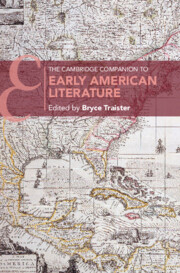Book contents
- The Cambridge Companion to Early American Literature
- The Cambridge Companion to Early American Literature
- Copyright page
- Contents
- Figures
- Contributors
- Introduction
- Part I How to Read (in) Early America
- 1 How to Read Things That Weren’t Written Down in Early America
- 2 How to Read the Natural World
- 3 How to Read Early American Poetry
- 4 How to Read Gender in Early America
- 5 How to Read an Early American Novel
- 6 How to Read Democracy in the Early United States
- Part II Readings in Early America
- Part III Early American Places
- Select Bibliography
- Index
- Cambridge Companions To …
3 - How to Read Early American Poetry
from Part I - How to Read (in) Early America
Published online by Cambridge University Press: 18 November 2021
- The Cambridge Companion to Early American Literature
- The Cambridge Companion to Early American Literature
- Copyright page
- Contents
- Figures
- Contributors
- Introduction
- Part I How to Read (in) Early America
- 1 How to Read Things That Weren’t Written Down in Early America
- 2 How to Read the Natural World
- 3 How to Read Early American Poetry
- 4 How to Read Gender in Early America
- 5 How to Read an Early American Novel
- 6 How to Read Democracy in the Early United States
- Part II Readings in Early America
- Part III Early American Places
- Select Bibliography
- Index
- Cambridge Companions To …
Summary
How do you get to grips with an early American poem? A good toolbox of critical approaches and perspectives will include formal analysis, material texts, cultural work, race and gender, reception and reading practices, together with an inquisitiveness about the various ways in which a poem makes connections. It also helps to know some of the key uses to which poetry was put by English-speaking colonists in the seventeenth and eighteenth centuries. Worn pages show Puritan readers using devotional poems to support their daily piety in early New England. Manuscript elegies offered consolation to bereaved family members, and published broadsides shaped the values of the wider community. Commemorating a public figure could enable a socially marginalized writer, such as Phillis Wheatley, to find an authoritative poetic voice. Epistolary exchanges of poems among coteries allowed some educated eighteenth-century women to pursue their friendships and intellectual development despite being barred from public careers. Throughout the period, allusions ranging from homage to parody, illustrate the transatlantic adaptation of British genres and styles to American circumstances. In the revolutionary period, anonymous and ephemeral newsprint poetry whipped up patriotic feeling, while a handful of poets published their work in elegant volumes.
- Type
- Chapter
- Information
- The Cambridge Companion to Early American Literature , pp. 49 - 67Publisher: Cambridge University PressPrint publication year: 2021



